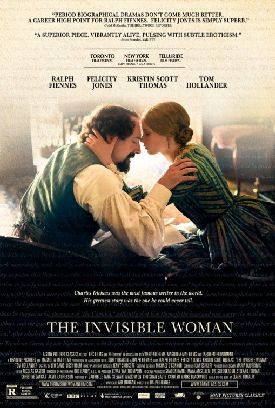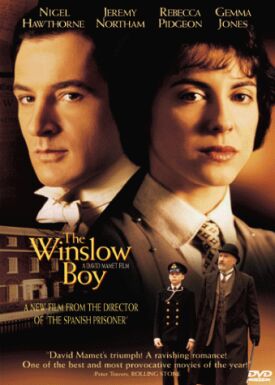The Invisible Woman
The epigraph to Ralph Fiennes’s The Invisible Woman, adapted from Claire Tomalin’s biography of Ellen Ternan, is naturally taken from Charles Dickens, of whom the latter was mistress during the last years of his life: “A wonderful fact to reflect upon, that every human creature is constituted to be that profound secret and mystery to every other.” The context, in the Tale of Two Cities, is of love and death. The “profound secret and mystery” is another way of expressing the individuality that we love, when we love, and that we mourn in those we love after their death — at least partly because the elusive promise of discovering the secret and plumbing the mystery must now be acknowledged as forever to be unfulfilled. How far that opinion was held by Dickens the man and not as a narrative or thematic convenience for the author is, perhaps, his own mystery, taken with him to the grave. But a fascination with and a need for secrecy itself becomes for Mr Fiennes the key to unlock the mystery of the great man’s love affair, which wasn’t generally known about until long after his death.
The trouble is that Felicity Jones, who plays “Nelly” Ternan to Mr Fiennes’s Dickens, is so lovely and charming that she makes the affair virtually self-explanatory and quite without any need for mystification of any kind. Why wouldn’t he want to possess her? And, as he already had a wife and ten children, not to mention a position of social prominence much like that of the celebrities of today, why wouldn’t he also want to keep their relationship a secret from the world? Of course the absence of mystery from the audience’s point of view does not obviate the need for it in Dickens’s own mind which, like that of many men in a similar situation, would very likely have revolted against the sordidness of the reductive interpretation of its own actions. Dickens may well have needed to believe in the ineffable mystery of his lust in order to avoid seeing it as mere lust. The question for viewers of The Invisible Woman is whether or not he, or Mr Fiennes on his behalf, is successful in persuading us to see it in the same way?
Everyone will have his own answer to that question, but I think the movie has a limited success in making us see Dickens’s passion for Nelly as he must have seen it — mainly because of its persuasiveness in making its case that this is how Dickens must have seen it. We can well believe that he would have spoken to Nelly with the words he put into Pip’s mouth in speaking to Estella in Great Expectations, which he was writing at the time of the affair’s commencement. “Estella, to the last hour of my life, you cannot choose but remain part of my character, part of the little good in me, part of the evil.” As a seduction line, this seems to have been more successful for Dickens with Nelly than it was for Pip with Estella, though the movie shows Nelly as being entirely in agreement with Dickens about the original ending of Great Expectations, in which Pip and Estella are meant to be seen as being forever sundered. We are left to draw our own conclusions, then, as to what must have passed between the author and his bien-aimée when he took Wilkie Collins’s advice instead of hers and put Pip and Estella together at the end.
Collins, played by Tom Hollander, appears in the film chiefly as the representative of what at the time still seemed like new and progressive thinking about sex and marriage, as he lives openly with a woman (Michelle Fairley) who is not his wife, in defiance of conventional morality and to the considerable shock of Nelly, who at least has the decency to keep her affair secret. Dickens’s open-mindedness about his friend’s domestic arrangements suggests that his secrecy about his own is less for his own protection than for Nelly’s. She, of course, would have known that she risked social ostracization if it had got out. Likewise, the film uses as a framing device scenes depicting Nelly more than a decade after Dickens’s death, when she is married to a school-master named George Wharton Robinson (Tom Burke) and has borne the latter two children. She is depicted taking long walks on the beach at Margate, where her husband keeps his school, and confiding her now long-ago secret to an elderly clergyman and Dickens enthusiast (John Kavanagh), though unsurprisingly she is still unable to reveal it to her husband.
One supposes that the point is further to stress the connection between love and secrecy — to the point, even, of implying — as, to be fair, Dickens himself does in the quotation from Tale of Two Cities — that love of people is, or can be, really a love of secrecy, or at least the promise that secrecy so tantalizingly hides. As a way of looking at Dickens’s love affair, that idea has its own congeniality to the media culture of today, though most of the media of today appears to be determined to take the movie as being instead the most conventional sort of feminist attack on Victorian hypocrisy and “patriarchy” That can have been no part of Mr Fiennes’s purpose, and his Dickens’s charm as a parent and a friend, as well as a public figure — though not, obviously, as a husband to his poor wife, Catherine (Joanna Scanlan), from whom he brutally separates on taking up with Miss Ternan — must result from a determination to create a balanced portrait of the man. But the star and director may also be right to see in the story a foreshadowing of our own era. Dickens was, after all and as the movie is at some pains to establish, one of the world’s first celebrities as we know them today. I can well believe that it takes one to know one.
Discover more from James Bowman
Subscribe to get the latest posts to your email.







